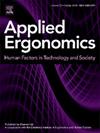Kinematic effects of a back-assistance exoskeleton during human locomotion
IF 3.1
2区 工程技术
Q2 ENGINEERING, INDUSTRIAL
引用次数: 0
Abstract
In the last years, Industry 5.0 has proposed a sustainable and resilient industry model, where the human-centric approach places human needs at the center of the production process. Wearable robots have been designed to assist users, providing support for the entire body or specific regions during task performance. Ergonomic investigations are necessary to test the effects, advantages and possible drawbacks of occupational wearable devices. The present study focuses on the biomechanics of locomotion while wearing the Laevo V2.5 exoskeleton. Experimental tests involved twelve healthy volunteers. Spatio-temporal parameters, human 3D kinematics and exoskeleton 3D kinematics were compared in three settings (without exoskeleton, wearing the exoskeleton without and with passive support). These comparisons aimed to quantify the effects and the possible restrictions on user kinematics due to the interaction with the exoskeleton. Results highlighted a significant reduction in the gait speed (1.14 m/s no-exo, 1.07 m/s exo-no-support, 1.05 m/s exo-with-support) and the stride length (1.29 m no-exo, 1.24 m exo-no-support, 1.23 m exo-with-support) when wearing the exoskeleton. Human angular kinematics showed significant reductions in the range of motion for all joints when wearing the exoskeleton. However, results pointed out no significant differences between the no-support and support configurations, indicating that the primary effect is due to the exoskeleton structure rather than the support provided. Further assessment is essential to determine whether these changes in human kinematics align with ergonomic standards and reflect user adaptation, or if they fulfill acceptable limits, potentially leading to long-term negative effects.
背部辅助外骨骼在人体运动中的运动学影响
在过去的几年里,工业5.0提出了一个可持续和有弹性的工业模型,其中以人为中心的方法将人的需求置于生产过程的中心。可穿戴机器人被设计用来协助用户,在执行任务时为整个身体或特定区域提供支持。为了测试职业可穿戴设备的效果、优势和可能的缺点,人体工程学研究是必要的。本研究的重点是佩戴Laevo V2.5外骨骼时运动的生物力学。实验测试涉及12名健康志愿者。比较了三种情况下(无外骨骼、无外骨骼和被动支撑)的时空参数、人体三维运动学和外骨骼三维运动学。这些比较旨在量化由于与外骨骼的相互作用对用户运动学的影响和可能的限制。结果显示,佩戴外骨骼时,步态速度(1.14 m/s无支架,1.07 m/s无支架,1.05 m/s有支架)和步幅(1.29 m无支架,1.24 m无支架,1.23 m有支架)显著降低。人体的角度运动学显示,佩戴外骨骼后,所有关节的活动范围都明显减小。然而,结果指出无支撑和支撑配置之间没有显着差异,这表明主要影响是由于外骨骼结构而不是所提供的支撑。进一步的评估是必要的,以确定这些人体运动学的变化是否符合人体工程学标准,反映了用户的适应性,或者它们是否达到了可接受的限度,可能导致长期的负面影响。
本文章由计算机程序翻译,如有差异,请以英文原文为准。
求助全文
约1分钟内获得全文
求助全文
来源期刊

Applied Ergonomics
工程技术-工程:工业
CiteScore
7.50
自引率
9.40%
发文量
248
审稿时长
53 days
期刊介绍:
Applied Ergonomics is aimed at ergonomists and all those interested in applying ergonomics/human factors in the design, planning and management of technical and social systems at work or leisure. Readership is truly international with subscribers in over 50 countries. Professionals for whom Applied Ergonomics is of interest include: ergonomists, designers, industrial engineers, health and safety specialists, systems engineers, design engineers, organizational psychologists, occupational health specialists and human-computer interaction specialists.
 求助内容:
求助内容: 应助结果提醒方式:
应助结果提醒方式:


